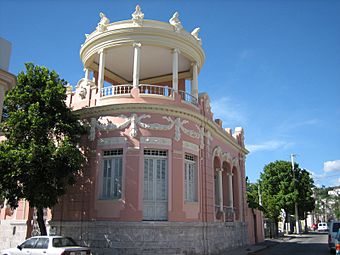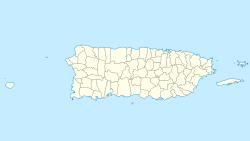Casa Wiechers-Villaronga facts for kids
Quick facts for kids |
|
|
Villaronga House
|
|

Casa Wiechers-Villaronga
|
|
| Location | 106 Reina St. (NW corner of Reina and Mendez Vigo streets), Ponce, Puerto Rico |
|---|---|
| Area | less than one acre |
| Built | 1912 |
| Architect | Alfredo B. Wiechers |
| Architectural style | Classical Revival |
| NRHP reference No. | 84003151 |
| Added to NRHP | 24 August 1984 |
The Casa Wiechers-Villaronga is a beautiful old mansion in Ponce, Puerto Rico. It was designed and built in the early 1900s. This house is a great example of the Classical Revival style. Today, it is owned by the Institute of Puerto Rican Culture. They have restored it, and it now serves as the Museo de la Arquitectura Ponceña. This means it's a museum dedicated to the architecture of Ponce. The house is located in the historic part of Ponce. It is one of only two homes still standing that were designed by the important architect Alfredo B. Wiechers. His work is a big part of Ponce's architectural history.
Contents
Why This House Is Special
The Wiechers-Villaronga Residence was built in 1912. It was designed by Alfredo B. Wiechers to be his own home and office. Later, he sold it to Mr. Julio Mercado. Mr. Mercado then gave it to his daughter, Elena Mercado, and her husband, Gabriel Villaronga, as a wedding gift.
About the Architect, Alfredo Wiechers
Alfredo B. Wiechers was born in Ponce. He went to the School of Architecture in Paris, France, in 1901. He was very talented and even won a gold medal for his excellent work there. After graduating in 1905, he worked in Barcelona, Spain, for a famous architect named Enric Sagnier.
In 1911, Wiechers decided to move back to Ponce. He designed and built his house and studio, which opened in 1912. In a short time, from 1911 to 1918, Wiechers designed many important buildings in Ponce. These included the Loggia Aurora, Club Deportivo de Damas, the Havana Theatre, the Banco of Ponce Building, and the Santo Asilo de Damas Hospital. In these buildings, he showed off the European Neo-Classical style he learned from Enric Sagnier.
Architectural Style and Details
The Neo-Classical style is clear in most of Wiechers' buildings. It's especially noticeable in the Villaronga residence. This house has many rich and fancy details. You can see pilasters (flat columns), rough stone bases, cornices (decorative tops), and special decorations called "candelabra". There are also reliefs (carved designs) and motifs (repeated patterns). The columns have Ionic tops, which are all part of the Neo-Classical look.
The Villaronga Residence is a fantastic example of this style. It's one of only two homes left that Wiechers designed. This makes it very important to the history and culture of Ponce's architecture.
Original Furniture and Art
What makes this house even more special is that all the furniture is original. Even the bathroom fixtures are from when the house was first built! Most of the furniture is in the Modernisme style, which is a type of Art Nouveau from Spain. It was brought all the way from Barcelona. The beautiful hanging tapestries (wall hangings) were painted by an artist named Librado Net.
History of the House
The house was designed in 1911 by Alfredo Wiechers, who was its first owner. It was built in the same year by Elías Concepción Albizu. In 1918, the Villaronga Mercado family bought the house. The house was officially added to the U.S. National Register of Historic Places in 1984. It was listed under the name Villaronga House.
Design and Appearance
The Casa Wiechers-Villaronga is considered a "treasure trove of culture." It's like a jewel among the many old mansions in Ponce that have been saved and turned into museums. The building has detailed neoclassical designs. It also features a grand gazebo on the roof. Inside, you'll find a complete set of original, custom-made Catalan modernist furniture. The shower and bathroom fixtures are also very well-preserved.
Outside the House
The Wiechers-Villaronga Residence is shaped like a "U". It has one story and is located at the corner of Reina and Mendez Vigo Streets. Even with all its fancy decorations, which show European Baroque influence, the house is mainly Neo-Classic in style. This mix creates a unique and elegant look.
The building sits on a base of rough stone. Its main walls are made of brick. Some inside walls, like those in the gallery and kitchen, are made of wood. Wooden beams support a roof made of galvanized zinc. The windows and doors are made of wood. They have movable louvers (slats) and fixed colored glass pieces.
Different types of flooring are used throughout the house. There are native cement tiles in the dining area and entrance hall. The living area and bedrooms have wood floors. The bathroom has ceramic tiles, and the entryway has marble tiles.
Baroque Influences and Details
The Baroque style can be seen right away in the building's rounded corners. This was a common feature for homes in Ponce. The corner has two rough stone pilasters and is divided into three sections. Each section has a wooden window with glass at the top and a flower design above it. The rest of the wall is decorated with flower garlands. The corner also has a round sitting area called a "glorieta," with Ionic columns.
Another interesting part of the house is its balconies. They are divided into three parts with Ionic columns. They are framed with Baroque moldings and carved faces at the top center. The iron railings on the balconies are designed in the Art Nouveau style. The outside walls are topped with a continuous stone cornice. Above this, a battlement-style parapet (a low wall) with carved lion faces and "candelabra" decorations adds to the roofline.
Inside the House
The main entrance is on Reina Street, not exactly in the middle of the building. The entrance hall has carved tiles. The door is at the end of a marble staircase. The inside of the house is well-kept and looks much like it did originally. The rooms are painted in different colors. The walls have decorative plastered Art Nouveau friezes (bands of decoration). Most ceilings are made of decorated embossed tin with a continuous decorative molding in the corners.
The gallery and part of the kitchen walls are wooden. They have fixed wood louvered windows for good air flow and light. Other cool details include the bathroom fixtures, like the shower stall and ceramic wall tiles, which came from Barcelona, Spain. The light fixtures in the dining room, master bedroom, and living room also came from Spain. There's also a "medio punto" in the dining area, which is a special architectural feature common in southern Puerto Rico.
Who Owned the House
Alfredo Wiechers Pieretti designed the house himself. His father was from Germany, and his mother was from Corsica. Alfredo was born in Ponce and studied architecture in Paris. He lived in Barcelona for six years, working in a famous studio. After leaving his mark on Ponce with buildings like Casa Serralles (1911) and Casa Oppenheimer (1913), he sold the house to the Villaronga family. He moved to Barcelona in 1919. Even though he designed many buildings between 1911 and 1918, including hotels, stores, and factories, most of his work was in Ponce. He only designed two buildings outside Ponce for wealthy families in the nearby mountain towns of Adjuntas and Aibonito.
The house was bought by Don Julio Mercado, who was Helena Mercado's father. He gave it to Helena Mercado as a wedding gift when she married Mr. Villaronga. This information comes from Luis R. Mercado, a great-grandchild of Julio Mercado.
Restoring the House
The Institute of Puerto Rican Culture (ICP) restored the house in the early 1990s. It is now open as the Museum of Puerto Rican Architecture. The furniture, which is all original, tells a story about life in Ponce in the early 1900s. The different rooms in the house show various aspects of Ponce's architecture.
The Museum Today
The museum opened in 1996. Its goal is to show off Ponce's rich architectural history. The building itself is seen as a "gem of fine Art Nouveau." It has a large collection of displays and photos of amazing works by architects like Blas Silva Boucher, Francisco Porrata Doria, Alfredo Wiechers Pieretti, and other important local architects from the early 20th century.
The city of Ponce is sometimes called the "guardian of Puerto Rican criollismo" (a term for local culture). It was chosen to be part of the European Union's Art Nouveau Route. This is because of its "world preservation of modernist heritage."
See also


